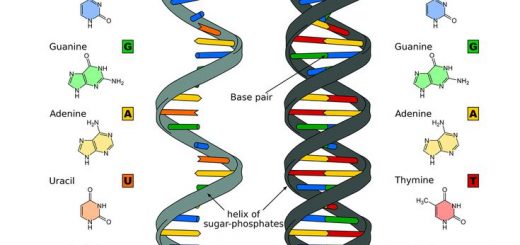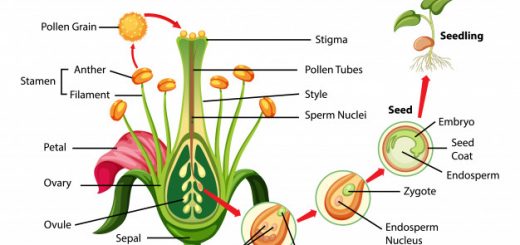Structure of Nucleic Acid (DNA), Enzymes, DNA replication and DNA repair mechanism
DNA is made up of four nitrogenous bases which may be a derivative of Pyrimidines & Purines, pyrimidines are single ring as thymine (T) & cytosine (C), Purines are double rings as adenine (A) & guanine (G), In the early of 1950’s there was a strong evidence that DNA carries the cell’s genetic information and many researches were trying to find out the structure of the DNA molecule to make a model of it.
Structure of DNA
DNA strand is made up of nucleotides, each nucleotide consists of three parts which are:
- A five-carbon sugar (Deoxyribose).
- The phosphate group is connected by a covalent bond to the fifth carbon atom of the deoxyribose sugar.
- The nitrogenous base is connected by a covalent bond to the first carbon atom of the deoxyribose sugar.
The nucleotides are linked together in a strand of DNA, as follows:
- The phosphate group that is attached to the carbon atom no. (5) (pronounced “five prime”) of the deoxyribose sugar of one nucleotide, attaches by a covalent bond to the carbon atom no. (3) of the sugar of the next nucleotide, The strand in which the sugar alternates with the phosphate is called “sugar-phosphate backbone”.
- The backbone is not symmetric because it has a definite orientation with a free (3¯) hydroxyl group (OH) in the deoxyribose sugar at one end and a free (5¯) phosphate group in the deoxyribose sugar at the other end.
- The purine and pyrimidine bases stand out from one side of the sugar-phosphate backbone.
The number of pyrimidine and purine nitrogenous bases in the DNA molecule is equal because :
- The number of nucleotides containing adenine (A) equals the number of nucleotides containing thymine (T), i.e. (A=T).
- The number of nucleotides containing guanine (G) equals the number of nucleotides containing cytosine (C), i.e. (G=C).
Direct evidence on DNA structure (Franklin’s studies)
Franklin used the X-rays diffraction technology to get pictures of highly purified DNA crystals, as :
- X-rays pass through the crystals of DNA molecules which have a regular structure.
- It is resulted from this, a scattering of X-rays which produced a pattern of dots that its analysis gave information about the shape of the DNA molecule.
Results of Franklin’s studies about DNA structure
In 1952, Franklin published such photographs of the crystals of a highly purified DNA, where she has shown that :
- DNA is twisted into a spiral or helix, where the bases are perpendicular to the length of the fiber.
- The sugar-phosphate backbone is located outside the helix, while the nitrogenous bases are inside.
- The diameter of the helix shows that it must be composed of more than one strand of DNA.
After Franklin published her pictures of DNA, the two British scientists Watson and Crick were the first to create an acceptable model of DNA.
Model of DNA structure by Watson and Crick
Watson and Crick model of DNA structure is made up of two strands that are arranged like a ladder, as the ladder’s sides are the sugar-phosphate backbones of the two strands and the ladder’s rungs are the nitrogenous bases.
The rung may consist of either :
- Adenine (A) paired with thymine (T) by two hydrogen bonds.
- Guanine (G) paired with cytosine (C) by three hydrogen bonds.
All the rungs of the ladder have the same width along the DNA molecule, and two DNA strands are always on the same distance from each other because each rung consists of a pair of a single ring ( pyrimidine) and another double rings (purine).
The two nucleotide strands of the DNA molecule had to run in opposite directions, because the direction of one of the two strands is (5¯ → 3¯ ), while the direction of the opposite strand is ( 3¯ → 5¯) that means the free (5¯) phosphate group of the two DNA strands in pentose sugar is at the opposite ends of the molecule to form the hydrogen bonds between the paired nitrogenous bases in a correct form.
The whole ladder of DNA is twisted, with ten nucleotide pairs per turn to form the spiral or helix of DNA ( i.e. ten nucleotides per turn on one strand), because the spiral is composed of two strands wounded around each other, so, the DNA molecule is called a “double helix”.
DNA replication
Before the division, the DNA molecules are replicated (or duplicated), as each new cell receives a complete copy of the original cell’s genetic information.
Watson and Crick pointed out that the double-stranded and base-paired structure of the DNA molecule incorporates means, where the genetic information can be replicated accurately, Because the two strands have complementary base pairs, so, the nucleotides sequence of each strand automatically supplies the information needed to produce its partner (i.e. each old strand of DNA acts as a template to produce a new complementary DNA strand).
Example:
- If a portion of one strand runs (5¯..A−A−T−C−C.. 3¯), its partner must run (3¯..T−T−A−G−G..5¯).
- If the two strands of the DNA molecule are separated, each strand can be used as a mold or a template to produce its complementary strand.
Enzymes and DNA replication
The replication of DNA demands the integrated action of many enzymes and proteins in the cell, For replication to occur, the following must happen:
The double helix must be unwounded, The DNA-helicase enzymes move along the double helix, separating the two strands from each other by breaking the hydrogen bonds between the paired nitrogenous bases, The strands separate from each other, so, they can form new hydrogen bonds with the new nucleotides partners, DNA-polymerase enzymes build the new DNA strands, where :
In the strand (3¯ → 5¯) that is the original template: The DNA-polymerase enzymes build the new DNA strand which catalyze the addition of monomers (nucleotides) one by one from the beginning (5¯ ) to the end (3¯ ) of the new strand, a monomer (nitrogenous base in the nucleotide) must be paired with the base exposed on the opposite template DNA strand.
DNA polymerase can work only in one direction from the (5¯ ) end towards the (3¯ ) end, So, It can build a new strand complementary to the template DNA strand (3¯→ 5¯ ), It can’t build a complementary strand to the opposite strand ( 5¯ → 3¯ ), except with the help of DNA-ligase enzyme.
In case of ( 5¯ → 3¯ ) that is the opposite template strand: The DNA-polymerases made small fragments of DNA strand in the direction ( 5¯ → 3¯ ) and these small fragments are soon joined together by another enzyme “DNA-ligase”, as DNA-polymerase can’t work in the direction (3¯→ 5¯ ).
Replication of DNA in prokaryotes: In prokaryotes, DNA exists in the cytoplasm as a double helix and its ends are joined to form a circle, The molecule is attached to the plasma membrane at one point where the replication occurs.
Replication of DNA in eukaryotes: DNA of eukaryotes is organized into several chromosomes, each chromosome contains a single DNA molecule which runs from one end of the chromosome to the other end and replication starts at any point along the molecule.
DNA repair
All the biological polymers ( such as starch, protein and nucleic acids) are subjected to damage, Polymers are long molecules formed of repeating units, DNA is considered from the biological polymers that are subjected to damage, as the human cell loses daily about 5000 purine bases (A and G) from DNA found in it.
The causes of DNA damage ( causes of the biological polymers damage):
- Heat (body’s heat) which breaks the covalent bonds that link the nitrogenous bases to the deoxyribose sugar.
- Aqueous environment inside the cell.
- Chemical compounds.
- Radiation.
Effect of DNA damage
Any form of damage in DNA molecule could alter its information contents and produce disastrous changes in the cell’s proteins, Although thousands of changes occur in the DNA molecule every day, no more than two or three stable changes are accumulated in the cell every year.
Because the vast majority of these changes are eliminated with remarkable efficiency by a group of 20 different kinds of DNA repair enzymes which are DNA-ligases, while the changes that continue in the cell are due to the occurrence of damage in the two strands of DNA at the same location and the same time.
DNA repair mechanism
DNA-ligases recognize the damaged area of DNA, then repair it by replacing the damaged nucleotides with new complementary nucleotides to those on the strand opposite to the damaged portion, then the DNA structure remains constant when transferring to the new generations, From this we found that DNA-ligases play an important role in the genetic stability of the living organisms that contain them.
DNA repairing depends on the existence of two copies of the genetic information, one in each strand of the double helix, as it must be one of these strands remains undamaged, so, the repair enzymes can use it as a template to replace the damaged segment on the other strand, Therefore, most the damages are remedied, unless both strands are altered (exposed to a damage) at the same location and the same time.
The genetic material of some viruses presents in the form of a single-stranded RNA which can’t be repaired, These viruses show high rates of genetic changes, resulting from the damage of their RNA, So, the mutations increase.
From the previous, we conclude that: The double helix is vital to the genetic stability of the living organisms that contain it, There are conditions in which can’t be repaired the damage of the genetic material, which are:
- The two strands of DNA are exposed to the damage at the same location and the same time.
- The genetic material of viruses is in the form of a single-stranded RNA.
Enzymes meaning, function, examples & Mechanism of enzyme action
Genes, Chromosomes, Proteins, Bacteriophages & Quantity of DNA in the cells
Packaging of DNA, Genome, chromosomal proteins, DNA in Prokaryotes & Eukaryotes
Regulation of the cell cycle, DNA synthesis phase, Interphase & Mitosis
Importance of Nucleosides, Nucleotides, Purines, Pyrimidines & Sugars of nucleic acids



